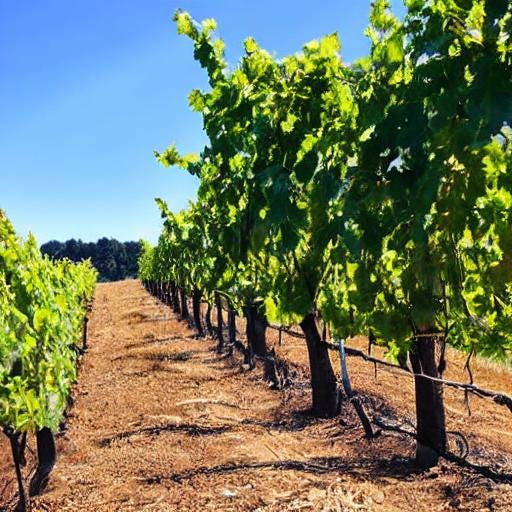Precision Viticulture - Uses, Applications and Challenges
Precision Viticulture is a modern approach to vineyard management that uses data analytics and machine learning to optimize grape production and wine quality.
Precision Viticulture is a modern approach to vineyard management that uses data analytics and machine learning to optimize grape production and wine quality. Several wineries and vineyards around the world use Precision Viticulture to optimize grape production and wine quality. Here are some examples of wineries and vineyards that use Precision Viticulture:
1. Jackson Family Wines in California, USA, uses Precision Viticulture to monitor soil moisture and plant health, reducing water usage by up to 25% [4]. The winery uses a combination of remote sensing and soil sensors to collect data on vineyard conditions. The data is then analyzed using machine learning algorithms to optimize irrigation and fertilization schedules.
2. Château Mouton Rothschild in Bordeaux, France, uses GPS mapping to identify areas of variability in soil type and topography, allowing them to adjust irrigation and fertilization schedules accordingly[4]. The winery uses a combination of GPS mapping and soil sensors to collect data on vineyard conditions. The data is then analyzed using machine learning algorithms to optimize irrigation and fertilization schedules.
3. Bodega Catena Zapata in Mendoza, Argentina, uses remote sensing to monitor plant health and grape quality, allowing them to make informed decisions about when to harvest grapes[4]. The winery uses a combination of remote sensing and soil sensors to collect data on vineyard conditions. The data is then analyzed using machine learning algorithms to predict grape quality and optimize harvest schedules.
4. Villa Maria Estate in Marlborough, New Zealand, uses Precision Viticulture to optimize irrigation and fertilization schedules, reducing costs and increasing yields[4]. The winery uses a combination of remote sensing and soil sensors to collect data on vineyard conditions. The data is then analyzed using machine learning algorithms to optimize irrigation and fertilization schedules.
5. Yalumba Family Vignerons in Barossa Valley, Australia, uses Precision Viticulture to monitor soil moisture and plant health, reducing water usage by up to 50% [4]. The winery uses a combination of remote sensing and soil sensors to collect data on vineyard conditions. The data is then analyzed using machine learning algorithms to optimize irrigation and fertilization schedules.
First Understand Terroir & Climate Change
Precision Viticulture, Terroir, and an Overview of New and Old Wine-Producing Regions of The World
At the heart of precision viticulture applications are a few important considerations. For example - why do we see certain wine types dominant in given regions e.g. Sangiovese in Tuscany, Italy or Sauvignon Blanc in Marlborough? The answer lies in distinguishing the Mediterranean vs Maritime climate structure. And of course the topography - hilly vs flat. Also soil types - limestone or sandstone vs alluvial or clay and gravel. Everything that gets summed up in the french term “terroir”.
It’s simple really. You cannot fix or improve something unless you first understand it. And “terroir” lies at the crux of the Precision Viticulture application world.
This article on the Top 15 Wine Producing Regions and their terroir provides a wonderful overview and summary.
The Role of Climate Change and Impact of El Nino
Climate change and El Nino have a significant impact on vineyards and wineries. Rising temperatures, droughts, and extreme weather events can damage grapevines and reduce wine quality. Precision Viticulture can help mitigate these risks by providing vineyard managers with real-time data on weather conditions, soil moisture, and plant health. By using this data, vineyard managers can adjust irrigation and fertilization schedules to ensure that grapevines receive the optimal amount of water and nutrients.
What is Precision Viticulture about? Data Collection and Analytics!
Data Collection Techniques
Precision Viticulture relies on various data collection techniques, such as remote sensing, GPS mapping, and soil sensors. Remote sensing involves using satellites or drones to collect data on vineyard conditions, such as plant health, soil moisture, and temperature. GPS mapping is used to create detailed maps of vineyards, which can be used to identify areas of variability in soil type, topography, and microclimate. Soil sensors are used to measure soil moisture, temperature, and nutrient levels, providing vineyard managers with real-time data on soil conditions.
Data Analytics and Machine Learning
This is the next step. Data needs to be processed. Data analytics and machine learning are used to analyze or process the data collected from vineyards. Machine learning algorithms can identify patterns in the data, such as the relationship between soil moisture and grape yield. This information can be used to optimize irrigation and fertilization schedules, reducing costs and increasing yields. Data analytics can also be used to predict grape quality, allowing vineyard managers to make informed decisions about when to harvest grapes.
So ultimately, if done well, these main benefits ensue i.e. improved cost management, increased yields, and improved wine quality.
Challenges & Limitations For Precision Viticulture
Precision Viticulture is not without its challenges and limitations. Implementing Precision Viticulture can be challenging, as it requires significant investment in technology and data analytics expertise. Additionally, data collection can be time-consuming and expensive, and the quality of the data collected can vary depending on the accuracy of the sensors used. Finally, there is a risk that vineyard managers may become overly reliant on technology, neglecting the importance of human expertise in vineyard management.
What The Future of Precision Viticulture looks like?
The future of Precision Viticulture is likely to involve the integration of new technologies, such as artificial intelligence and the Internet of Things (IoT). These technologies will allow vineyard managers to collect and analyze data in real time, providing them with even more accurate and timely information on vineyard conditions. Additionally, Precision Viticulture is likely to become even more important in the face of climate change, as vineyard managers seek to mitigate the risks associated with rising temperatures and extreme weather events.
Citations:
[1] https://www.sciencedirect.com/science/article/abs/pii/S0172219021000399
[2] https://www.abdn.ac.uk/geosciences/documents/Precision_Viticulture_tools_Fraigneau.pdf
[3] https://www.sciencedirect.com/science/article/pii/B9781845694845500129
[4] https://swfound.org/media/206832/see-lab-study-case-workshop.pdf
[5] https://www.mdpi.com/2073-4441/14/9/1493
[6] https://www.infowine.com/en/infowine_premium/managing_within_field_variability_through_precision_viticulture_italian_case_studies_sc_20100.htm


